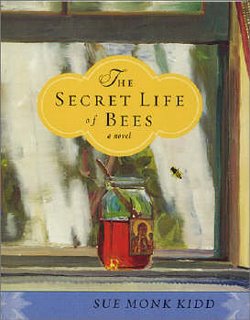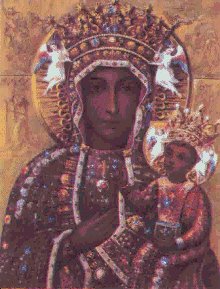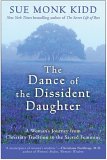 I finished reading the book "The Secret Life of Bees" by Sue Monk Kidd the other day.
I finished reading the book "The Secret Life of Bees" by Sue Monk Kidd the other day.Yesterday's post was kind of heavy, and I don't want to forget all that, but maybe sometimes being accountable to the responsibility left us by martyrs is following our passions and working for God's glory in every area we are involved in. That's why I tend to write posts about books I read and movies I see--because even these expereinces are "sacraments," places where God can and does speak to us and call us to transformation.
So about this book...
 It's a story about a young girl coming-of-age, of course, as many books are. She lives in the South in the '60s. The story deals with spirituality, racism, grief and loss, joy and love. Lily, the main character, lost her mother when she was little and has only a few possessions left that belonged to her mother. One is a picture of the Black Madonna, and she is drawn to this picture--she doesn't know why. She knows it's strange, because Mary's supposed to be white, connoting purity and virginity. But this was her mother's. On the back her mother wrote the name of a town, and when Lily is forced to run away she heads for that town.
It's a story about a young girl coming-of-age, of course, as many books are. She lives in the South in the '60s. The story deals with spirituality, racism, grief and loss, joy and love. Lily, the main character, lost her mother when she was little and has only a few possessions left that belonged to her mother. One is a picture of the Black Madonna, and she is drawn to this picture--she doesn't know why. She knows it's strange, because Mary's supposed to be white, connoting purity and virginity. But this was her mother's. On the back her mother wrote the name of a town, and when Lily is forced to run away she heads for that town.In the story she meets up with a group of African American women who keep bees, who teach Lily how to live and love and grieve and be honest and to connect with her spirituality.
 It's an amazing book, and I've also read another one by Sue Monk Kidd called "Dance of the Dissident Daughter," which isn't a novel but tells her story and her thoughts as she found herself in a fundamentalist Christian environment and came to know God as her Mother, using feminine imagery and symbolism. I used that one as a source for a couple of papers I wrote last term.
It's an amazing book, and I've also read another one by Sue Monk Kidd called "Dance of the Dissident Daughter," which isn't a novel but tells her story and her thoughts as she found herself in a fundamentalist Christian environment and came to know God as her Mother, using feminine imagery and symbolism. I used that one as a source for a couple of papers I wrote last term.Now, the "religion" the women in "The Secret Life of Bees" is not exactly "Christian," they're worshiping Mary. (One could say that's as Christian as Catholicism, but I think if you ask most Catholics they'll tell you they're not actually worshiping Mary, just praising her for being the mother of Christ. The women in the story are actually worshiping her.) I don't think we should worship other people, but at the same time, what are women supposed to do? Who are we to identify with?
I think what almost always happens in religion is that something becomes an idol. People start out with good intentions, taking out every idolotrous thing, focusing on God alone, trying to get back to the basics of truth and love of God. But then over time whatever it was they chose to do in order to follow God better becomes an idol. I think that's what has happened with the Christian idea of God, as I alluded to some in my post on the Trinity. We have this view of God as the Father, Son and Holy Spirit, nothing more, nothing less. These are the ways we are allowed to picture God. Anything else has to fit into one of these categories or it's not "orthodox." (Even liberal Quakers are guilty of this to some degree, because by saying we can't define God and we can think of God however we want we've decided what people have to believe in order to be acceptable.)
But isn't that us deciding what God looks like? Isn't that us limiting God? Isn't that us making God fit our own image and not allowing God to knock our socks off by being something completely Other than what we could ever imagine?
It's a hard balance. I think we need common language to talk about God with, and imagery is helpful for us to grasp some piece of the relationality of this Other we're connected to. Having a common ground to speak about God is helpful because we need each other in order to understand God better. We can't just say God is whatever we want God to be. But we also need to be able to see God in new and creative ways or our faith has become dead and idolatrous.
This is something I'm passionate about, and I hope as we allow God to imagine God's self to us we can be challenged from a space of a love we can understand because it fits us personally, and because it allows our community to see the Light of God in a clearer fashion. Hopefully as we allow God to imagine God's self to us we can imagine ourselves being who God calls us to be and live that out in radical, transformative ways.
3 comments:
Can you say more about God imagining God's self to us? Is this away of talking about this that you've come up with, or are you referencing someone else talking about God imagining God's self to us? I guess I'm not familiar with this language.
Creation is like a distant mirror which God made, but which has been broken into pieces.
It's amazing how close your comment and charlie chocco's are (see comments on next posting on spring). The only problem with this analysis is the age-old question, did God make a mistake? Did God create this beautiful mirror which would perfectly reflect God to us and to God's self, and then it accidentally broke? Did God know it would break? How could a perfect creation break? Could God create something that wasn't perfect to begin with?
This all kind of has to do with what I was posting about recently regarding predestination. Interesting questions to ponder...
Post a Comment